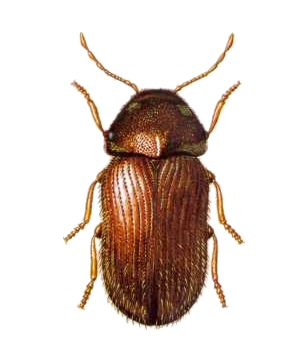Drugstore Beetle, Cigarette Beetle
 Scientific Name
Scientific Name
Stegobium paniceum, Lasioderma serricorne
Symptoms
Cigarette beetles commonly infest dried tobacco and tobacco products. They also infest raisins, figs, dates, ginger, pepper, nutmeg, chili powder, curry powder, cayenne pepper, paprika, drugs, legume seeds, barley, cornmeal, flour, soybean meal, sunflower meal, wheat, wheat bran, rice meal, beans, cereals, fish meal, peanuts, dry yeast, dried flowers, leather, woolen cloth, and bamboo. They have been known to damage the leaves and bindings of books when feeding on the paste and overstuffed furniture when infesting the stuffing (hair, straw, etc.).
Drugstore beetles will feed on many drugs, including poisonous substances such as belladonna and strychnine. They infest almonds, peanuts, paprika, red pepper, alfalfa meal, cornmeal, flour, milo, wheat, wheat bran, wheat germ, dry dog food, bread, beans, coffee beans, fish meal, spaghetti, instant chocolate, powdered milk, books and manuscripts, dried flowers, and certain fillers and fabric coverings of furniture.
Life Cycle
 Both beetles can live from two to four weeks, and during this time, females can lay
30 to 100 oval, whitish eggs in foodstuffs. The eggs hatch in 7 to 20 days. Larvae
reach maturity in 30 to 50 days, and then pupate in a silken cocoon covered with bits
of the material on which they fed. The pupal period is 8 to 10 days long. The life
cycle can be completed in 40 to 50 days under ideal conditions. There are usually
three to six generations of cigarette beetles and one to four generations of drugstore
beetles each year. The beetles can fly but usually hitchhike in infested materials
distributed by man.
Both beetles can live from two to four weeks, and during this time, females can lay
30 to 100 oval, whitish eggs in foodstuffs. The eggs hatch in 7 to 20 days. Larvae
reach maturity in 30 to 50 days, and then pupate in a silken cocoon covered with bits
of the material on which they fed. The pupal period is 8 to 10 days long. The life
cycle can be completed in 40 to 50 days under ideal conditions. There are usually
three to six generations of cigarette beetles and one to four generations of drugstore
beetles each year. The beetles can fly but usually hitchhike in infested materials
distributed by man.
Description
 Adult cigarette beetles are yellowish to reddish brown, oval-shaped, and about 1/10
inch long. The head is bent downward sharply, giving the body a humpbacked appearance
when viewed from the side. The wing covers (elytra) are smooth. The antennae are uniformly
serrate (saw-like).
Adult cigarette beetles are yellowish to reddish brown, oval-shaped, and about 1/10
inch long. The head is bent downward sharply, giving the body a humpbacked appearance
when viewed from the side. The wing covers (elytra) are smooth. The antennae are uniformly
serrate (saw-like).
Adult drugstore beetles are reddish brown, more elongate, and about 1/10 inch long. The head is bent downward but does not result in a distinct humpbacked appearance. The wing covers are striated (faint lines running lengthwise). The antennae have three enlarged segments at the tip.
Larvae of both species are C-shaped grubs about 3/16 inch long when mature. Cigarette beetle larvae are creamy white and covered with long, yellowish brown hairs. They have a brown head and legs. Drugstore beetle larvae are similar but do not have the fuzzy appearance.
Control
Prevention
At the time of purchase, examine foods such as cornmeal and macaroni for infestations, and check the packaging date to establish freshness. Purchase seldom-used foods in small quantities to prevent long storage periods of one month or more. Susceptible foods should be stored in insect-proof containers of glass, plastic or metal, or store in a refrigerator. Use older packages before new ones, avoid spillage in cabinets, and always keep food storage areas clean.
Inspection
Locate the source of the infestation by carefully examining all seldom-used foods and least-disturbed storage areas. Inspect packages of pancake flour, spices, cornmeal, raisins, dry dog and cat food, birdseed, etc. Dispose of heavily infested foods in heavy plastic bags in the garbage, or bury deep in the soil. Lightly infested foods or food products where there are questionable infestations can be heated in shallow pans in the oven at 130 to 150 F for 30 minutes (or use a preheat setting of 30 to 45 seconds in a microwave oven) or placed in a deep freezer at 0 F for seven to ten days. Sifting the food material will remove most of the insect fragments and any remaining will not cause harm if consumed. Heat-treat dried fruits by placing in a cheesecloth bag and dipping in boiling water for about six seconds. Note: Seeds saved for planting may have the germination reduced by super heating or cooling.
Treatment
The use of insecticides should be supplementary to sanitation and proper food storage. Treatments are not effective on insects within the food packages. For control of beetles flying around windows and doors inside, use a household aerosol insecticide labeled for flying insects. For a treatment for cracks and crevices to control beetles, use a residual insecticide labeled for use in food storage/handling areas. Before treatment of cabinets and other storage areas, remove all food, food packages, utensils, dishes, and other food-related items. Cover these items to prevent accidental spray drift. Vacuum cabinets and shelves to pick up spilled and loose infested food, then scrub with soap and hot water. After drying, spray lightly, forcing spray into cracks and crevices, or apply with a paintbrush. After the spray has dried, cover shelves with clean paper or foil before replacing food and cooking utensils. Please contact your local county extension office for current information.

